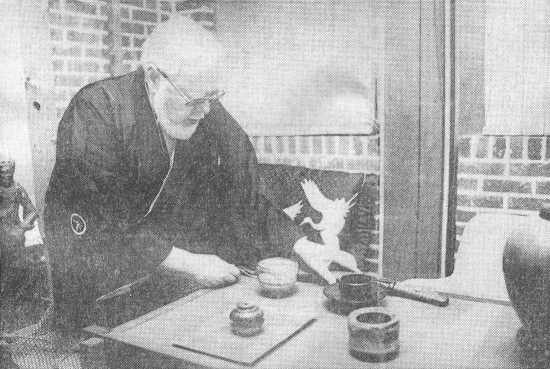 Col. Dean Hartley prepares tea at this residence in Monroe |
Many men collect guns, some collect knives. Dean Hartley collects swords of the samurai. "There is a mystique about it (samurai sword)," Hartley explained. The samurai warrior wore two swords and a distinctive headdress. He prized honor above wealth or life, and atoned for dishonor by committing hari-kari, or ceremonial suicide. Hartley said these finely-crafted swords couldn't be compared to modern weapons. "Revolvers are all made by machines. Every single Japanese sword qualifies to become a samurai sword. It is an example of the best that that highly qualified expert could do at the time. It is made by one man - putting everything he has into it," he added. Originally, the term samurai referred only to the Japanese imperial guards. After the coming of a feudal system to Japan, it meant the entire military class, including the samurai warrior, the feudal lords (daimyos), and the sho-gun. The Northeast Louisiana University assistant professor of aviation and retired U.S. Marine colonel has collected Japanese-made swords and other artifacts for more than three decades. |
|
His first sword - a war souvenir, was obtained in Guam at the beginning of World War II. "It was a military issue, not a genuine samurai sword," the former U.S. Marine pilot recalled. While the military issue piqued his curiosity, Hartley said he did not become seriously interested until he read a book about samurai swords written by John Yumoto. After reading the book, he wrote Yumoto - asking him about the souvenir sword plus two others he had obtained. "I became hooked. I started looking in gun shops, pawn shops ... out of the first 10 I looked at, six were very good swords," he recalled. Since then, Hartley has collected about 35 samurai swords that he keeps locked in a vault, as well as tea bowls, kimonos, and assorted other oriental artifacts. He has also become knowledgeable in Japanese and Chinese history. "To put a sword into proper perspective, you have to know the history of that time," he explained. "Each type of sword was made by a swordsmith of that time to fit the need of that time. Swords made during wartime were heavier and darker, while peacetime swords were lighter and more decorative." Also, he said a third type of sword, a dress sword, was designed for high officials who never went into combat. Those swords were decorative, almost to the point of being gaudy and they had a dull iron blade or a wooden blade. Hartley also said many swords have been shortened and the name of the sword maker is missing. "They were adjusted to the size of the man who used them. The greatest swordsmith was Masamune. He worked around 1230 A.D. Masamune discovered a method of heating a sword to make it more durable without the sword breaking." Learning something about the history of the swords of the samurai warrior started Hartley to collecting tea bowls and other oriental artifacts. "When the battle is over, the samurai settles down to quiet, reflective things - he sets down to drink tea. I said, well, if I'm going to collect swords I have to collect tea bowls. Some are not very pretty, but I have conditioned myself. I see beauty where some people may say: Yuk!" Seeing beauty in different things is not difficult for Hartley. A chemist by profession, his first love is art and he has several portraits to his credit. "The pleasure I get from collecting swords and pottery is a representation of the things I have learned about the country and its people. Plus, I have a deep regard of beauty in all forms. These," he said indicating a couple of crude looking bowls, "are representations of that." Hartley is twice past chairman of the Japanese Sword Society of the United States, and he is currently chairman of the organization's board of directors. He is also an honorary consulate of the Japanese Art Sword Preservation Society. Hartley, who has been associated with the Aviation Department at NLU since 1971, obtained a master of arts degree from Stanford University in 1951. |
 The handle of a samurai sword |